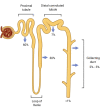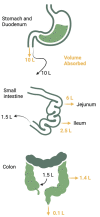Dysnatremia in Gastrointestinal Disorders
- PMID: 35646996
- PMCID: PMC9136014
- DOI: 10.3389/fmed.2022.892265
Dysnatremia in Gastrointestinal Disorders
Abstract
The primary solute of the milieu intérieur is sodium and accompanying anions. The solvent is water. The kidneys acutely regulate homeostasis in filtration, secretion, and resorption of electrolytes, non-electrolytes, and minerals while balancing water retention and clearance. The gastrointestinal absorptive and secretory functions enable food digestion and water absorption needed to sustain life. Gastrointestinal perturbations including vomiting and diarrhea can lead to significant volume and electrolyte losses, overwhelming the renal homeostatic compensatory mechanisms. Dysnatremia, potassium and acid-base disturbances can result from gastrointestinal pathophysiologic processes. Understanding the renal and gastrointestinal contributions to homeostatis are important for the clinical evaluation of perturbed volume disturbances.
Keywords: chloride; diarrhea; emesis; homeostasis; hypernatremia; hyponatremia; sodium.
Copyright © 2022 Do, Evans, DeAguero, Escobar, Lin and Wagner.
Conflict of interest statement
The authors declare that the research was conducted in the absence of any commercial or financial relationships that could be construed as a potential conflict of interest.
Figures





References
-
- Ackerman G. Serum Sodium. In: Clark VL, Kruse JA, eds. Clinical Methods: The History, Physical, and Laboratory Examinations 3rd edition. Boston: Butterworths. (1990). - PubMed
Publication types
Grants and funding
LinkOut - more resources
Full Text Sources

